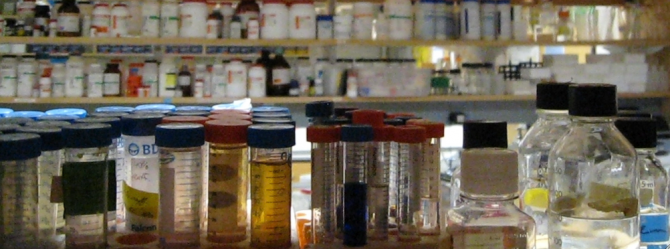Difference between revisions of "20.109(S08):Characterize protein expression (Day5)"
From Course Wiki
(→Part 2: SDS-PAGE of protein extracts) |
(→Part 2: SDS-PAGE of protein extracts) |
||
| Line 62: | Line 62: | ||
| | | | ||
| | | | ||
| + | | | ||
| | | | ||
|} | |} | ||
Revision as of 16:53, 31 December 2007
Contents
Introduction
Protocols
You may find it helpful to prepare the solutions you will need for Part 3 (or at least the relevant calculations) before beginning Part 1.
Part 1: Lysis of cells producing mutant protein
- You will be given an aliquot of room temperature BPER (bacterial protein extraction reagent), which also contains 0.1% bovine serum albumin (BSA, a stabilizer), and a protease inhibitor cocktail to guard against protein degradation. When you are ready to begin, add 1:1000 of cold enzyme mixture (obtained from teaching staff).
- Per cell pellet, add 300 μL of enzyme-containing BPER and resuspend by pipetting until the solution is relatively homogeneous.
- Vortex for 30-60 seconds.
- Incubate the solutions (at room temperature) for 3 min.
- Finally, spin for 3 min. at maximum speed and transfer supernatants to fresh tubes.
Part 2: SDS-PAGE of protein extracts
- Last time you measured the amount of cells in each of your samples. (If you ran cultures overnight, the teaching faculty measured the +IPTG samples for you and emailed you the results.) Look back at your measurements, and find the sample with the lowest cell concentration. Set aside 15 μL of this sample for PAGE analysis.
- For your other five samples, you should take the amount of bacterial lysate corresponding to the same number of cells as the lowest concentration sample. For example, if the OD600 of your WT -IPTG sample was 0.05, and the OD600 of your WT +IPTG sample was 0.30, you would take 15 μL of the -IPTG, but only 2.5 μL of the +IPTG sample.
- Next, add enough water so the each sample has 15 μL of liquid in it. You might use the table below to guide your work.
| Sample/Lane # | Sample Name | OD600 | Volume Sample | Volume Water |
|---|---|---|---|---|
| 1 | ||||
| 2 | ||||
| 3 | ||||
| 4 | ||||
| 5 | ||||
| 6 |
- Now add 15 μL of 2X sample buffer to 15 μL of each of your diluted lysates. Also retrieve a 15 μL sample of MW markers from the teaching faculty.
- Boil all seven eppendorfs for 5 minutes in the water bath.
- You will be shown by the teaching faculty how to load your samples into the gel. You might load your samples according to the table above.
- Note the starting and stopping time of electrophoresis, which will be initiated by the teaching faculty at 200 V, and run for 30-45 minutes.
- Pry apart the plates using a spatula, and transfer your gel to a staining box. Add Coomassie Brilliant Blue, and incubate for 1 hour.
- The teaching faculty will show you how to transfer your gel to destaining buffer in the fume hood.
- Replace the staining buffer after about 1 hour.
- Tomorrow, the teaching staff will transfer each gel to water, then photograph them and post the results to the wiki. You will have a chance to physically observe your gels next time.
Part 3: Protein purification
All spins should be performed at 7000 rcf for 1 min.
Part 4: Protein Concentration
- Prepare 10 mL Bradford reagent from the 5x concentrated stock by adding water.
- Obtain BSA standards from the teaching faculty. The standards were prepared in elution buffer, since imidazole has some absorbance at 590 nm.
- Aliquot 10 μL of each standard (0.1-1 mg/mL) into labeled eppendorfs, as well as 10 μL of elution buffer alone as a control.
- Add 1 mL of Bradford reagent to each standard, as well as to your ?four? unknown protein samples. Incubate 10-20 min at room temperature.
- Measure the absorbance of each sample at 590 nm.
